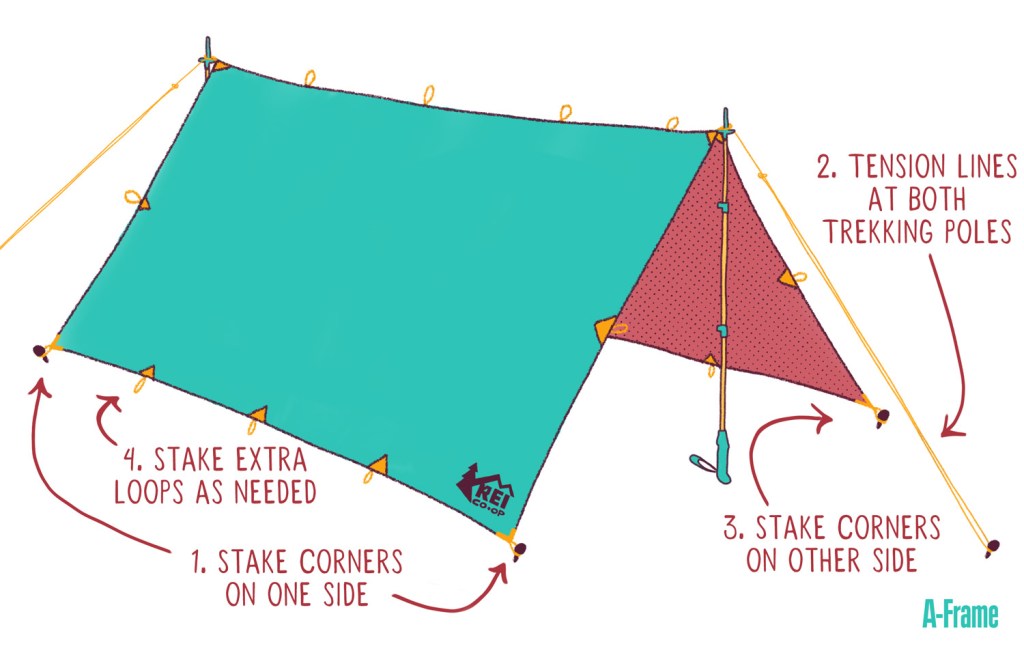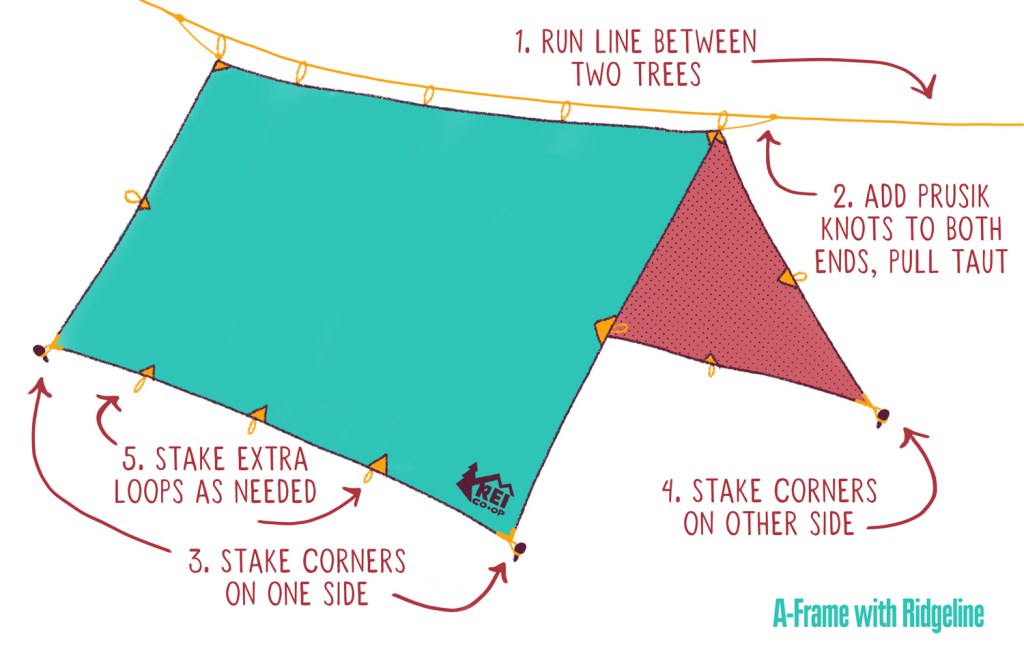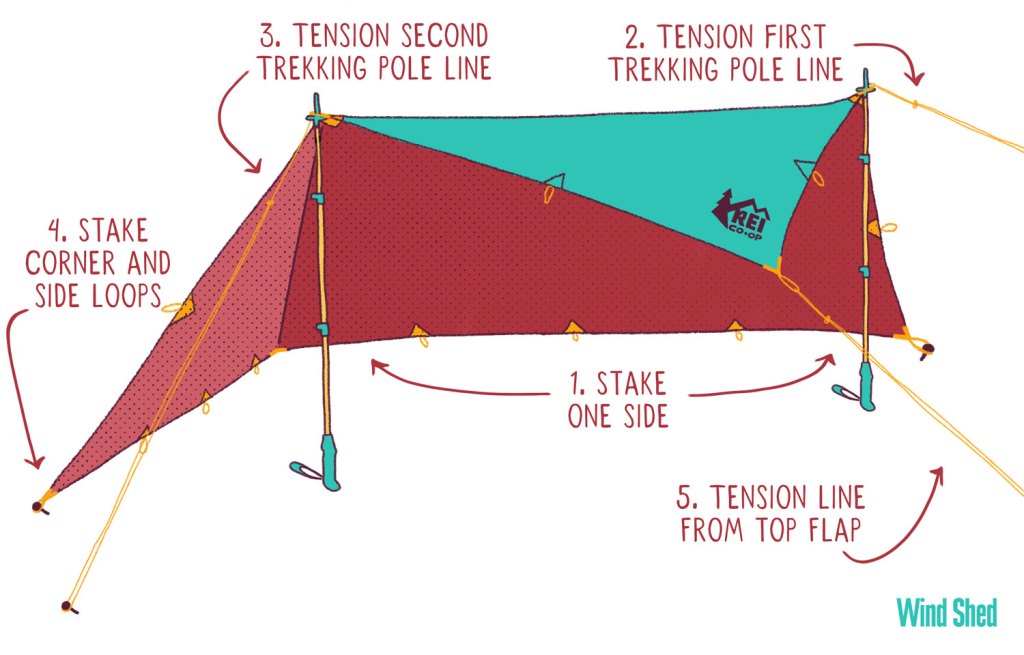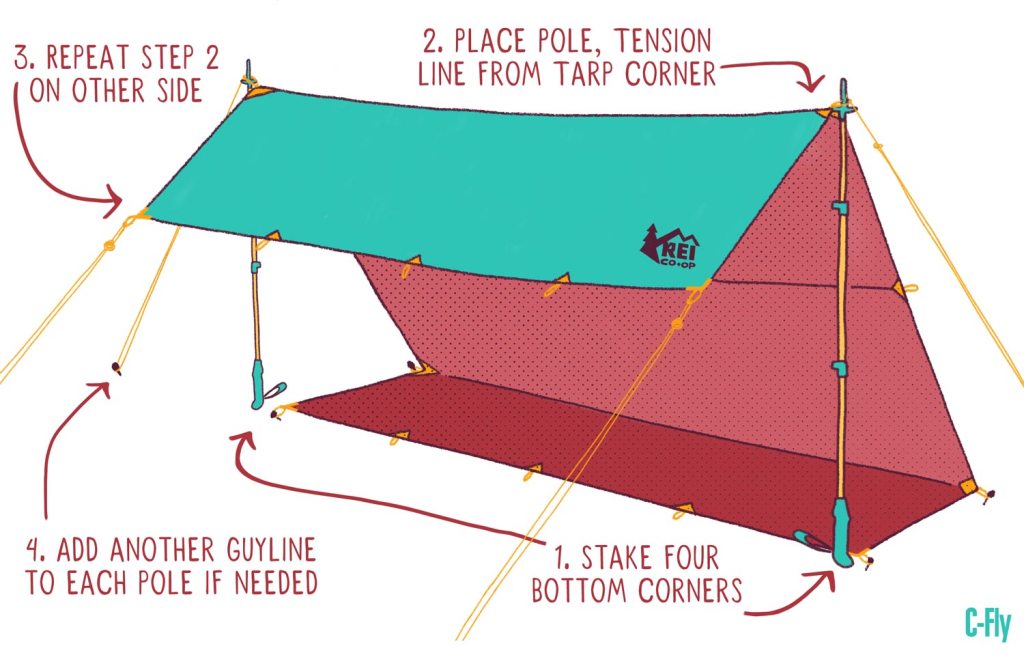Thru-hikers and minimalist backpackers love using tarps instead of tents because tarps are ultralight and take up very little space in a pack. And those backpacking tarp shelters are nothing like the big blue tarps at your hardware store; instead, they are made of a thin-yet-strong nylon or polyester that’s either waterproof or highly water resistant.
Tarp shelters have the following features:
- Grommets for pole tips at the middle of each side of the tarp
- Sturdy reinforced loops at the corners and along the edges to allow you to stake them down or attach and stake down guylines (or attach those guylines to objects like trees)</li>
- Some tarps might also have extra loops to add guylines in strong winds
- Some tarps might also have loops along the centerline at the top of the tarp to let you set up a ridgeline
Tarp Shelter Setup Supplies
Tarp shelters vary a little in what comes with them, but your basic supply needs are few:
The tarp: Many are square, which works for the setups in this article. Sizes and shapes vary—backpacking tarps are in the 9’ x 9’ range and weigh 1 pound (or more).
Guylines: Typically included; some are pre-attached and/or might have tensioners or cleats built in for setup ease. All you really need is some cord and knot knowledge, though.
Additional cord: Typically not included, this lets you create a ridgeline, add extra guylines or extend guylines.
Stakes: Most, but not all shelters, include them; you might also want to bring along an extra stake or two to give you more setup options and in case you lose or break one.
Poles: Most shelters are designed to work with trekking poles (not included), though a few might come with their own shelter poles.
A big appeal with tarp shelters is their versatility: They can be set up many different ways, which is part of the fun. Below, we’ll cover a few basic setup options for new tarp shelter users.
Three Knots to Know
You can use a wide range of knots, so if you’re an accomplished cord wrangler, tarp setup is a time when you can show off those skills. If you’re like many of us, who find anything beyond our shoelaces to be a challenge, then spend a few minutes learning three simple knots:
The bowline: For securing a guyline to a guyout loop or a tree trunk. (See our video tutorial)
The trucker’s hitch: For securing—and tensioning—a guyline to a stake or a tree trunk. (See our video tutorial)
The prusik: Allows you to adjust tautness by sliding the hitch freely until it is held in place by tension; used for securing the front and rear edges of a tarp along a ridgeline. (See our video tutorial)
A-Frame Setup
This classic tarp setup with the corners attached to the ground should give you enough space for two people to sleep under it.

Here’s how to set up your tarp shelter as a classic A-frame:
- Stake down both corners on one edge of the tarp.
- Put your trekking poles midway along what will become the front and back edges of your shelter (angled slightly). Then stake down and lightly tension their guylines to hold the poles in place.
- Stake down corners on the other side of the tarp and then further tighten the trekking poles’ guylines.
- Stake down other loops on the sides of the tarp as needed to secure the shelter and keep it taut.
You can adjust your headroom by lengthening or shortening your trekking poles and repositioning the corners. If you want even more space and ventilation, raise the whole thing (including the poles) and guy out the corners and sides a few inches off of the ground. You can also adjust overall shelter tautness by repositioning and retensioning guylines and stakes.
Setting Up a Ridgeline for Your Shelter
If you don’t want to carry trekking poles and if you’ll to be in an area with trees, use a ridgeline to set up the A-frame (and other shelter setups).

Here’s how to set up a ridgeline for your tarp shelter:
- Run a cord through the top loops along the centerline of the tarp (or underneath along the length of the tarp if it has no top loops).
- Tie a bowline knot around one tree.
- Tie a trucker’s hitch to the tree on the other side (to tighten the ridgeline).
- Tie a prusik knot so that it goes through the front pole grommet and around the ridgeline. Do the same at the rear pole grommet.
- Slide each prusik knot along the ridgeline until the tarp is taut along that line.
- Stake and tension the corners and sides of your tarp shelter.
Closed-End A-Frame Setup
This alternative to the classic A-frame gives you a little more protection from wind and rain. The back end is essentially closed, so wind and wind-driven rain can’t blow in from that side.

Here’s how to set up your tarp shelter as a closed-end A-frame:
- Stake down the middle point at what will become the back of the shelter.
- Put your trekking pole at the front (angled slightly), then stake down and lightly tension its guyline to hold the pole in place.
- Stake down the front two corners.
- Stake down the back two corners.
You can adjust your headroom by lengthening or shortening your front trekking pole and repositioning the front corners.
Wind-Shed Setup
As the name implies, this is really good for protection when the prevailing wind is coming from a particular direction. It’s also good if you’re backpacking somewhere warm and want to maximize your view of a nearby lake or mountain.

Here’s how to set up your tarp shelter as a wind shed:
- Stake down one side of the tarp.
- Put a trekking pole (angled slightly) in the middle of an adjacent side of the tarp. Then stake down and tension the pole’s guyline (at about a 90° angle from that side of the tarp).
- Put the other trekking pole (angled slightly toward the front of the shed) in the middle of the side of the tarp that’s opposite the staked-down side. Then stake down and lightly tension the pole’s guyline (at about a 90° angle from the guyline holding the other pole).
- Stake down the corner near that pole and stake down that side of the tarp.
- Add a short guyline to the remaining corner on the tarp (at about a 90° angle from the guyline in Step 3). Then stake that guyline down and tension the line.
This setup might require you to play with the angles and tension on your guylines to maximize shelter tautness. Note, too, that if you want a really expansive view and have a tree nearby, you can switch the guyout point for the elevated shed corner up to that tree.
C-Fly Setup
Much like the wind shed, this offers open views, as well as protection when the prevailing wind is coming from a particular direction. It also offers the added bonus of providing a ground sheet to protect your sleeping setup from soggy soil.

Here’s how to set your tarp shelter up as a C-fly:
Note that this setup requires at least eight stakes.
- Stake down what will be the corners on your rectangular ground sheet section (as shown in the illustration above).
- Place a trekking pole to support one side of what will become the ridgeline. Add a guyline to that front corner of the tarp (at a 90° angle from the ridgeline). Then stake down and tension that guyline.
- Place the other trekking pole to support the other side of the ridgeline and repeat Step 2.
- Tension (retension) guylines until your shelter is taut. For added stability, add an additional guyline on each side coming out from the top of the pole (at a 90° angle from that side of the C-fly).
Note that you can also set up your C-fly using a ridgeline (see instructions above).
More Shelter Setup Options
After you’ve mastered some basic setups, you can experiment to create your own configurations for your backpacking tarp shelter. And we’ve omitted the most basic setup of all in a forest: Simply guy out each corner to a tree. If you plan to use your tarp in a car campground, or are looking for tips on setting up more conventional tarps, read Tarp Tips: Quick Shelter for Rain, Wind or Saving Weight.
